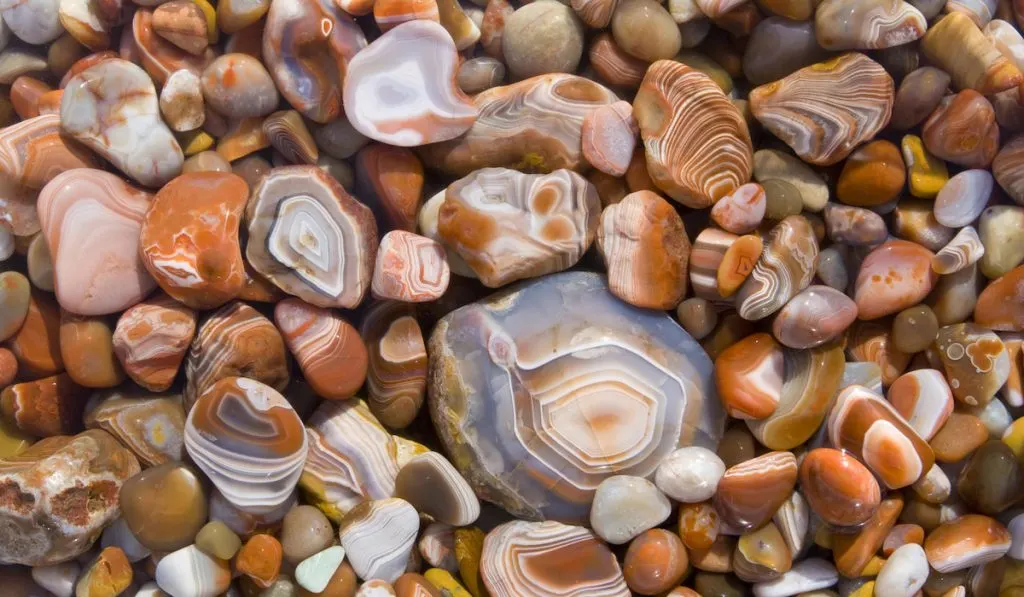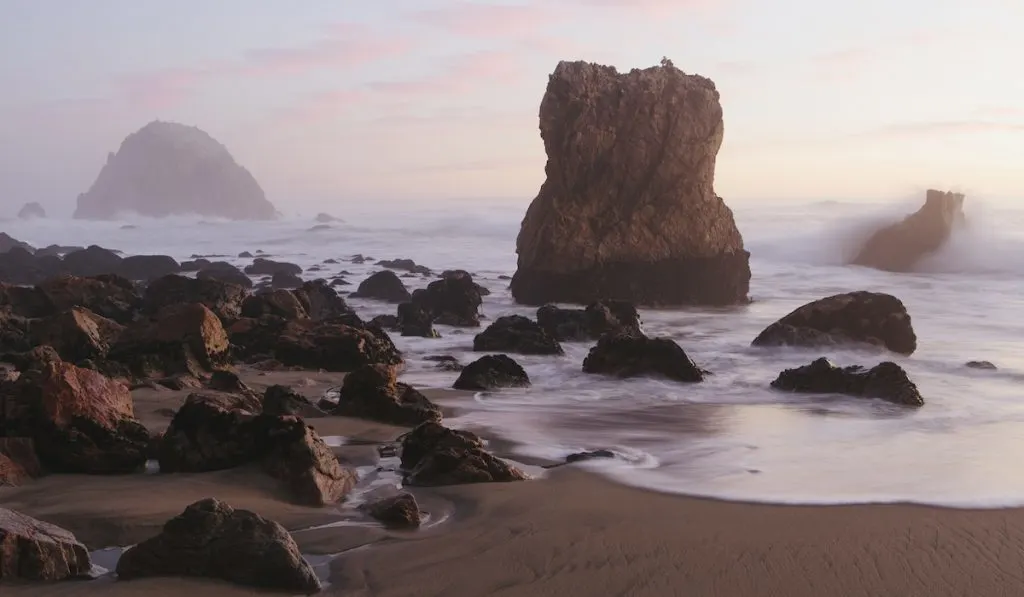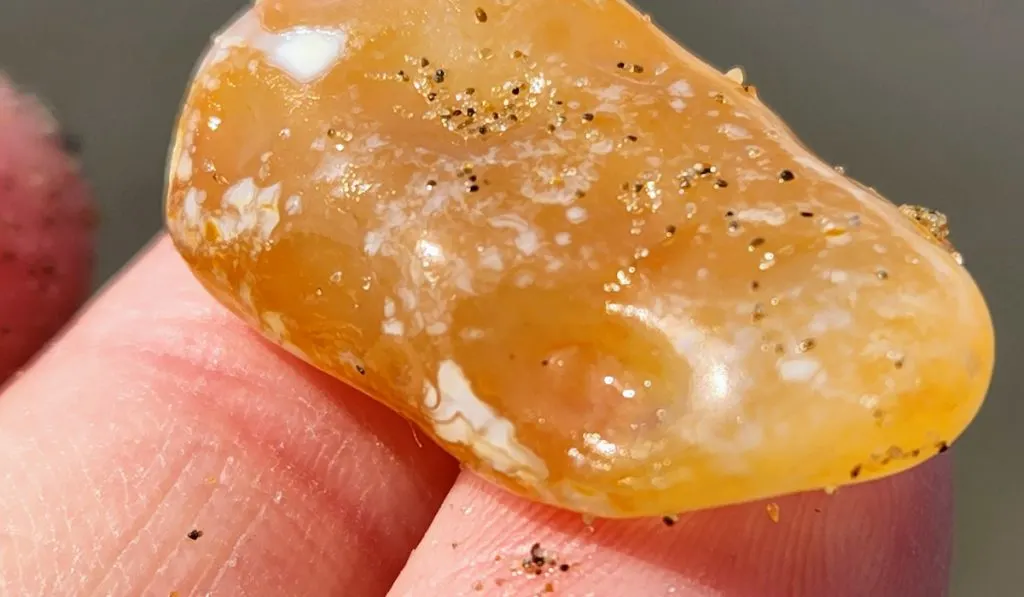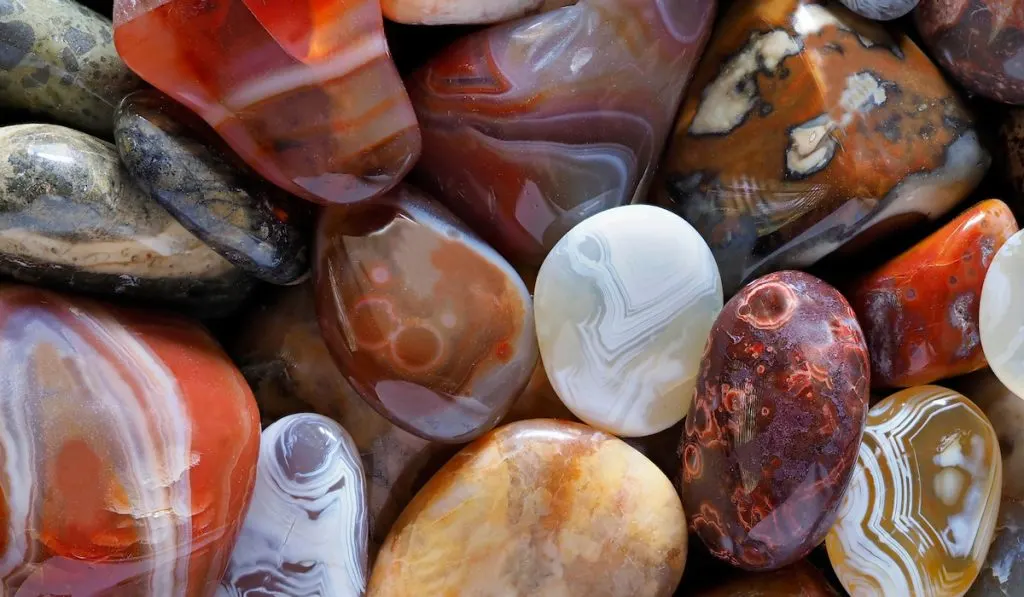For many rockhounds, agate hunting is the ultimate task to creatively and productively pass the time. Agates are naturally available in various colors and do not need extra tumbling. For this, they tend to be every rockhound’s most prized jewel in their collection of gemstones.
However, finding agates can be challenging because they are elusive, even to experienced hunters, especially if you don’t know where to look or exactly what to look for.
If you want to try your luck at collecting these nature tumbled treasures, I have prepared a few tips to guide you through the search process, but first, let’s learn a few things about agates.
What are Agates?
Agates are microcrystalline quartz-banded rocks found along beaches and gravel bars.
They stand out by their translucent nature and are regarded as semi-precious, especially if it is of a desirable color, texture, and quality.
How Do Agates Form?
Agates naturally develop as secondary deposits of silicon dioxide in hollow cavities of host rocks, called vesicles. These host rocks are mostly ancient volcanic lava rocks that were pushed to the surface through the volcanic rifts and cracks by air trapped within them. When the air finally escaped, it left behind vesicles, which form the basis of the partnering of the agates.
Layer by layer, the microcrystals organize themselves in the vesicles to create different patterns in every piece.
The difference in colors and patterns are greatly influenced by the changes in temperature, pressure, and mineral content that greatly varies during the formation process. It is also the reason why every agate comes with its unique intricate pattern.

How Do You Identify Agates?
Different agates have different colors because of their different mineral compositions. Some also have smooth surfaces, some have coarse textures, and all are found around the beach shores, so it shouldn’t be a hard task finding a pocketful. Regardless, how do you get confident that what you have picked is an agate?
Although agates always look different, they all have a few things in common: their translucent quality, banding patterns, and color.
When held up against the light, all agates always have a certain degree of opacity. Some agates might have a higher degree of opacity than others, but it all depends on factors such as the level of mineral content in each agate and their crystalline form.
Additionally, agates get an extra sparkle when wet, and a ray of light hits their surface. This way, it gets easier to distinguish them from the rest of the rocks.
With these details, you will be able to tell agates apart from other rocks on the beach, such as jasper.
9 Tips for Hunting Agates
Now that you know what agates are and how to distinguish them, how do you hunt for them? Here are a few tips to guide you through the process.

Look for Beaches with Exposed Gravel Beds
You’ll have more luck when hunting for agates around gravel beds. You may have a favorite agate hunting spot, but gravel beds often offer more agates than you would expect.
Although the gravel spots are mostly covered by sand, the ocean washes away the sand in instances of low tide, often leaving behind the agates for whoever comes first to find them. For this, the gravel beds are a hotspot for agates.
On the other hand, when river hunting for agates, the best time to search is when the water levels are low and the rock and gravel bars are exposed.
Avoid Crowds
If you want more luck with finding agates, learn to avoid crowds.
Hunt for agates before the place gets crowded, or avoid crowded places altogether and venture into other spots that are less occupied. This way, you will build better odds of getting more agates compared to when you are sharing hunting spaces. This is always applicable, even if you have a favorite spot.
How do you ensure you will avoid crowds? If you have a favorite spot for hunting, the early bird catches the worm. So make it a norm to go there early in the morning when other agate collectors are not yet up for the task.
If you can’t make it to your spot early enough to collect, you can visit beaches that do not attract crowds or sail to less-visited shores, like those of deserted islands.
These are mainly the catch for agates and petrified wood, jasper, and many more precious rocks.

Use the Sun to Your Advantage
As aforementioned, agates are translucent and will have some translucency when held against the sun. When the sun hits the rocks at just the right angle, agates give a reflection when their surfaces are wet, making them easier to find.
For the best experience with taking advantage of the sun, it gets more interesting early in the morning or late in the evening when the sun’s rays are just ambient enough but not intense. The sunlight gives agates a “glowing” effect, making them stand out from the rest.
Although the sun can be a rare commodity during winter, you can use a backup light source such as a flashlight to examine the rocks you pick.
Patience Is Key
You might be sure that your favorite spot will not miss agates, but still, you need to be patient to find them. Don’t plan to find a certain number of agates within a few minutes.
Instead, plan on spending hours out there and be satisfied with whatever you get after the period unless you are comfortable stretching the time. If you are not satisfied, give it a try another day.
Maximize Large Storms, Waves, and Low Tides
Whenever there is a storm or reports of large waves along the coastline, you better rush to the beaches whenever it is safe or as early as the following morning.
The ocean always has something new to offer. Winter months are accompanied by heavy storms and waves that wash more fantastic stones to the beaches. Low tides also offer prime agate hunting moments because you get to explore deeper into the coastline.

Don’t Walk too Slow
Every agate will give you something fantastic to wonder about, but you should keep that for later. Don’t give in to the temptation of examining the agates you collect right away. Instead, train your eyes to quickly recognize agates and filter out other rocks and this way, you will walk and work faster.
Know what You are Looking For
Whenever you go out for agate hunting, your eyes are bombarded with many exciting things on the beaches that it may get challenging to tell agates from other rocks. Learn to distinguish agates from petrified wood, jaspers, and other stones. The larger pieces might be easier to spot and pick out, but there are other lots of duller colored agates that you won’t instantly recognize as agates but will glow and burst out their wings after polishing by a rock tumbler.
If you are not confident with yourself, carry along a pack of agates to guide you with what to expect when hunting. To efficiently do this, drop an agate amongst other rocks and debris to point out the similarities and what to look for in other stones of the same kind.
Once you get confident spotting agates without any guidance, the task gets more accessible and better, no matter the agate’s size, shape, or color.

Utilize a Sand Scoop
Being a rock hunter, it gets hard to continuously bend down when looking for treasures hidden in the sand. A sand scoop should be handy in helping you reach down to the sand and pick up a scoop to find your treasure.
Depending on the scoop you use, some, like the Sand Dipper, are fitted with a telescoping rod and a piece of the sieve-like net at the scooping section. This is effective since it allows you to scoop the sand while the other debris gets sieved out with the sand, leaving you with the larger agates, shells, and other treasures to pick without necessarily having to bend down.
Hit the Jackpot Locations
Some hunting spots are more productive than others. However, that should not be the only thing that draws you to a particular spot.
Research new spots around you and expand your horizon, and even hit places with minimum human visits, and be sure to bring in a massive haul.
Conclusion
As much as it can be exciting to go rock hunting, you should know the best times and spots to get the best and as many agates as possible.
Above all, you should put safety first and always be geared up for any potential weather change while hunting for rocks. Also, avoid cliff edges, slick rock, and other potentially dangerous positions.
Resources
- https://visitdelnortecounty.com/article/hunt-for-agates-along-sandy-shores-in-crescent-city/
- https://www.rockseeker.com/agate-hunting-tips/
- http://www.agatesoftheoregoncoast.com/fieldtrip.html
- https://www.pnwbeachcombing.com/rocks.html
- https://oregondiscovery.com/beachcombing
- https://agatehunting.com/10-tips-for-more-successful-agate-hunting/
- https://rockhoundresource.com/all-about-agates-how-and-where-to-find-them/
